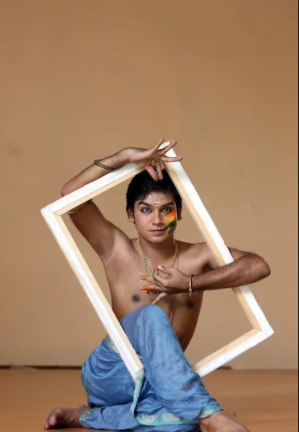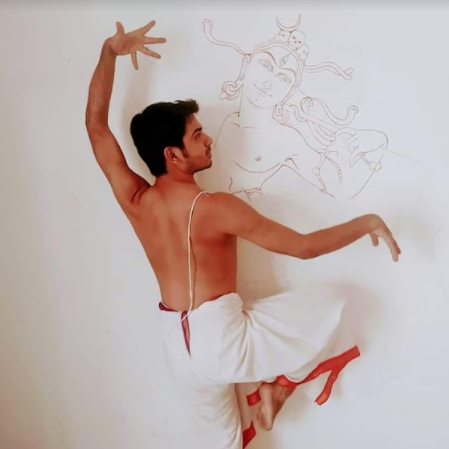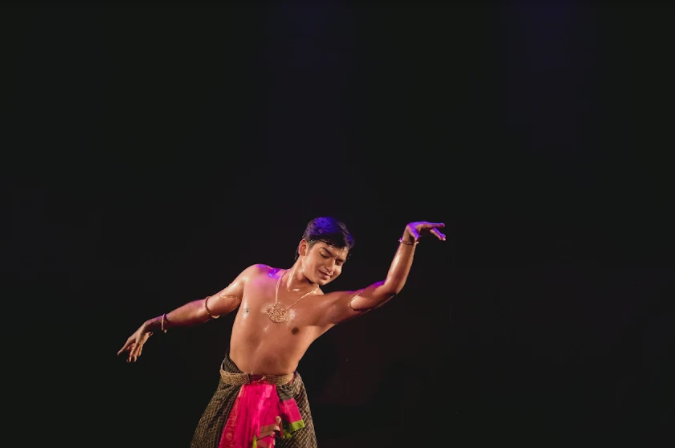
The techniques of art and dance in the world of performing arts is probably the most cherished and celebrated. Their reputation precedes them- the sheer bliss one experiences by even hearing the word ‘dance’, witnessing and performing it is unmatched. The beauty of both fine arts and dance lies in their versatile nature – the ability to modify and adapt to changes in the surroundings. This quality was demonstrated no better than in the pandemic- no matter how low a point they hit initially, dance forms managed to encompass the situation with its own grace. Similarly, strokes of a brush on papers give vent to the overwhelming emotions that were experienced during the pandemic. In this interview with Dr. Himanshu Srivastava, established Bharatnatyam dancer, research scholar and painting artist, we engage in a conversation where we discuss the impact of COVID-19 on the world of dance and vice-versa.
On being asked about the changes and their intensity that the pandemic has brought to his dance performances, Dr. Himanshu starts off on a very positive note by saying that art is all about change. “The first definition of art itself is change and if you cannot adjust to something that is not art.”,he says. The pandemic has badly affected various sectors including the arts sector. But artists and practitioners have the responsibility of continuing their art form with the same vigour as they were before- so the generations behind who look upto them can continue to be inspired and pushed towards what they want to achieve with their art. Initially, they started a little low- thankfully social media platforms and media practices came up and started off with online performances and series. “Somewhere yet we feel the whole beauty of the stage performance was missing in the online performances and that was something where we really had to make a change.” says Himanshu. That’s when they realized that practising their dance form till then had only been limited to an audience sitting in an oblong or square shape setting in front of them – and now this audience had been compressed into a small, condensed camera hole- the focus is only on one particular area.
Dancers are known to be their own makeup artists and supposed to be their own costume designers. Now they have suddenly become their own directors as well as they are supposed to guide the whole performance- the angles, the shots- every little step. Since the whole scenario has transformed into the online media, the performers feel like they have to change their presentation to appeal to people on social media platforms – within a few seconds you have to convey everything. The attention of the audience will stay once they adjust and present according to the media. ‘So yes, we are going through all that change and there is still a lot left to be learnt’, he says ‘The pandemic has had it’s pros and cons- it has taught and is still teaching us a lot.’
Elaborating more on what positive changes and downfalls the pandemic has brought upon the art form, Dr. Himanshu quotes the wise old saying ‘Rome was not built in a day’. Change happens gradually and has a trial and error philosophy. The fate of dance and social media platforms function the same way- it has it’s pros and cons. Network issues and connectivity becomes the first big-time hurdle towards any presentation and connection to the media. When they are lucky enough to have a good network, the lack of physical presence is another huge hurdle. Artists are so trained to the oral traditions- guiding a budding artist’s hand on paper or correcting a pupil’s dance positions- when all those physical ways of teaching are lost, the whole experience loses authenticity. “One has to be very careful during an online class of what the teacher is trying to say and what the student is grasping, because at our end it may seem like they’re learning correctly but it might be a false understanding from the above.” he says. So all that has to be transcended and it has become a double responsibility for the teachers to reach out to the students in a better fashion to cope with the lack of the physical presence.

Dr. Himanshu also feels that social media has proved advantageous for painters and people working in the fine arts industry. “One of my teachers taught me, ‘art is all about visibility.’ ” he recalls. “If you really wish to grow, then that art has to be visible.” A lot of positive criticisms and inputs are needed from everywhere- and a lot of that comes the moment you reach out to people. Earlier, there would be displays in art galleries or small, confined spaces but now it has become a global practice of bringing up all these things on social media platforms- which seem to be the only possible way of interacting during the present scenario. Again, it comes with its pros and cons. Artists need to be very sure about what platform is representing them, whether the art space has a good amount of publicity and incoming ratio- all that is extremely important. Despite all that, the outrage on social media is really large and global- Himanshu’s own company and brand Natyachitra for his artworks will be having its own website soon. He thus feels that we need to learn from these times- how to reach out and attain visibility.
Speaking about whether the galleries being shifted to a virtual mode has affected the spectators’ interpretation of the art, Dr. Himanshu feels that an artist has to be very careful when releasing their artwork. For a single artwork, there can be multiple interpretations. He shares a personal anecdote with us- ‘For example if I post a painting without a description, ten people would write back saying ‘Oh sir, I saw this in the painting and it was very divine’ or ‘Oh I could connect it with my personal life!’But at the end of the day the artist’s perspective is also equally important.’ What inspired the audience is also to be brought out – to know the intensity of the artist’s thought and paintwork. Saying so, social media has that advantage which already makes one globally available to all audiences. It is a responsibility on the artist’s shoulder to be alert and sensitive- they might have to put out a video or a writeup explaining their artwork or maybe a live interactive session with the viewers . This is something that Himanshu highly recommends as it is very essential for art to be understood, because the art is bigger than the artist. There is hence a wide multiverse of understanding which just needs to be channelised on the social media platforms.
Regarding the recent debates by critics about usage of personal spaces such as corridors and kitchens for the practice of classical dance forms instead of authentic stage rehearsals, Dr. Himanshu reiterates his previous point regarding art- the dancer too has to be extremely cautious and sensitive about where and how they are dancing. ‘Aesthetics are the first and foremost thing which is a crucial anga, which literally means a body part of the whole form. It’s a visual art- not just beautification but how you present it and produce that intensity for your audience’ he says. A presentation is food for thought – so even if you are crunched and have a small space, you can plan it accordingly. Make it artistic – a little beautiful and presentable so that there is no distraction for the audience- do not let their mind be aware of the space you’re dancing , only what you are dancing.

On being asked about whether the government or any NGO has provided any sort of aid or financial assistance to artists and whether it has reached all artists equitably, Dr. Himanshu maintains that it might take the government more time to take concrete steps regarding this. Besides that, a lot of NGOs have stepped up and tried to raise funds through auctions etc.. “Recently I just heard about a beautiful auction about all great dancers coming together and literally putting out on sale their beloved costumes which they would themselves never be ready to part with- and that was really touching for me. We say ‘Aano Bhadra’ and that is just how these artists are allowing things to flow in and out.”,he says. Artists might just be a handful of citizens of the country, but they are trying their level best to reach out to the people. Everybody is responsible not only for themselves. “As an artist, make yourself strong enough to take the responsibility of another artist- and that will really help you grow in your art,” he feels. “Initiatives are happening but it is not easy at all- but the way I see the arts community coming together at times, it’s really beautiful.” Through this interview, Dr Himanshu urges all such organisations to come up and do whatever is possible to support them and other upcoming artists who had begun practising their art in the pandemic. “Mankind has evolved from quadruped monkeys to such intelligent beings- we can definitely survive this and help out our fellow citizens.’
The same applies to the kind of help laymen can extend to support art at such a crucial juncture- he believes that with the right knowledge of classical dance forms and their significance, more people will definitely step in to support them.
About the long term implications of the pandemic on his own art form, Dr. Himanshu says that the dance community is indeed experiencing a major shift from the stage proscenium to media-oriented audience. The 2021 camera mode is on and with that they are learning- improving themselves to get into better presentation and trying to become self dependent. “It’s a self-empowering year- if you are not empowering yourself this year, I think you are missing out on a lot.” he concludes with a smile.
Performing arts is a sector which has millions of people associated with it and has helped people keep their sanity when they were stuck in their own homes- a lot of us relied on some form of art to power through this ordeal. Keeping all that in mind, Itisaras has started a petition on change.org urging the Ministry of Culture to come up with a plan of action not just to financially support the artists but also provide various innovative ways to support their art- especially folk artists and people living in marginalised areas with no access to the internet. Please support in this endeavour to propel this industry which impacts millions of people by signing and sharing it across all platforms.




What¦s Taking place i’m new to this, I stumbled upon this I’ve found It absolutely helpful and it has aided me out loads. I’m hoping to contribute & assist other users like its helped me. Good job.
I’m not sure why but this web site is loading extremely slow for me. Is anyone else having this issue or is it a problem on my end? I’ll check back later and see if the problem still exists.
so much superb info on here, : D.
Hello there, I found your website via Google while searching for a related topic, your web site came up, it looks good. I’ve bookmarked it in my google bookmarks.
I in addition to my guys were found to be looking at the nice things from the blog then the sudden I had a terrible feeling I had not expressed respect to the website owner for them. All the women were definitely so glad to see all of them and have truly been loving those things. Thanks for being so thoughtful and then for making a choice on this form of superb guides millions of individuals are really wanting to learn about. Our honest regret for not expressing gratitude to you earlier.
Hi there! This post could not be written any better! Reading this post reminds me of my good old room mate! He always kept chatting about this. I will forward this post to him. Pretty sure he will have a good read. Thank you for sharing!
I am glad to be a visitor of this pure web site! , appreciate it for this rare info ! .
As a Newbie, I am continuously searching online for articles that can aid me. Thank you
Hey are using WordPress for your blog platform? I’m new to the blog world but I’m trying to get started and create my own. Do you require any html coding expertise to make your own blog? Any help would be really appreciated!
Just what I was looking for, regards for posting.
Great post, you have pointed out some excellent points, I also think this s a very fantastic website.